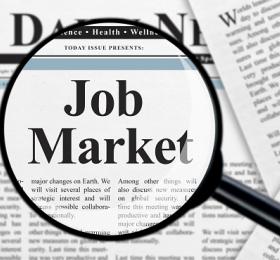
Strong jobs growth in May continues to signal tightness in the labor market even as the overall pace of hiring appears to be slowing. Payrolls expanded by 390,000 last month and the official unemployment rate held steady at 3.6%. Hourly earnings increased 0.3% MoM, which brings the annual increase to 5.2%. As an aside, inflation is still outpacing wage gains by a significant margin, which means further action by the Federal Reserve is to be expected (more on that below). Back to the latest from BLS, U6 ticked up to 7.1% with labor force participation also rising to 62.3% in May from 62.2% in the prior month. Who is shouldering the load? The private sector is doing the bulk of the hiring these days (333,000 last month) and that isn’t altogether surprising with fiscal stimulus all but gone. Deficit spending and MMT, modern monetary theory, seem like relics of the past. Meanwhile, the strong dollar is clearly having an impact on US manufacturers; manufacturing jobs made up only 13,000 of last month’s total. The bottom line is that this report continues to indicate a lack of equilibrium in laborland, BUT the tide might be turning (a tad bit)…
The US economy is throttling back in many respects, and there might not be a better place to look than the housing market. New home sales fell 16.6% MoM, but that doesn’t mean prices are deflating. In fact, Q1 data released last month indicate single family home prices have appreciated 21.2% YoY (Case-Shiller US National Home Price Index). However, we must also keep in mind that mortgage rates have roughly doubled since this time last year and perhaps more importantly job openings at American employers fell by 455,000 at the end of April. Though there are still ~2 jobs available for each unemployed American, affordability is a major concern. We would imagine further deterioration in demand is in the offing as we move through the heart of “homebuying season.”
Meeting, meetings, meetings… the FOMC met and raised rates by 50 bps to kick things off in May. Jay Powell was confirmed by the Senate to resume his post as head of the Federal Reserve, and in recent days, President Biden met with Chairman Powell in the Oval Office alongside Secretary Yellen to discuss inflation and the economic outlook. Mr. Biden made clear that he will not interfere with the Fed, but independence for the world’s most powerful central bank comes at a steep price these days! The US President simultaneously laid America’s inflation problem at Powell’s feet—not entirely surprising. To be clear, inflation is a global issue not simply a domestic nuisance. Central banks can influence demand; they cannot create supply. Speaking of supply-side issues, Mr. Biden is scheduled to visit Saudi Arabia, which earlier in the year snubbed his administration, to discuss oil output. The major questions here are: how much spare capacity do the Saudis really have and how willing will they be to tap it? There has been a lot of talk about the supply-side this year… let’s hope for some substance.
Cooling but not crashing is essentially the economic theme heading into summer. We are seeing domestic numbers drop across the board in both manufacturing and services; however, these declines seem to indicate tempered growth rather than an outright economic contraction. With financial conditions significantly tighter now than at the beginning of the year, one would certainly expect slower growth and we are beginning to see that now in the numbers. However, financial conditions have not tightened enough to signal that a demand driven economic “freeze” is imminent. After all, the American consumer is still in pretty good shape (personal spending AND retail sales increased 0.9% MoM)-- most are simply digging a bit deeper at the household level. Meanwhile, US corporates continue to crank out record profits. Thus, a prolonged period of stagnation or serious recession is not our base case at this time. The Federal Reserve is likely to continue its march to 2%+ (effective fed funds rate) in the coming months, but the path after that becomes a bit murky. What kind of shape the economy is in will be increasingly important should recent trends continue. As of today’s writing, markets are pricing for a terminal fed funds rate of ~3% by this time next year with most of the heavy lifting being done in 2022. To add some color to this picture… In the span of one month’s time, markets have pushed the Fed’s expected timeline out by nearly six months. Perhaps this illustrates an underlying conviction that Jay Powell (now officially confirmed) is moving off his backfoot with regard to inflation and will have the luxury of “data dependence” as early as this fall. Vigilance will be the key as we move through the next couple of quarters.
Market Outlook: Neutral USD, Neutral Duration, Neutral Equities
News Release: Bureau of Labor Statistics (The Employment Situation- May 2022)